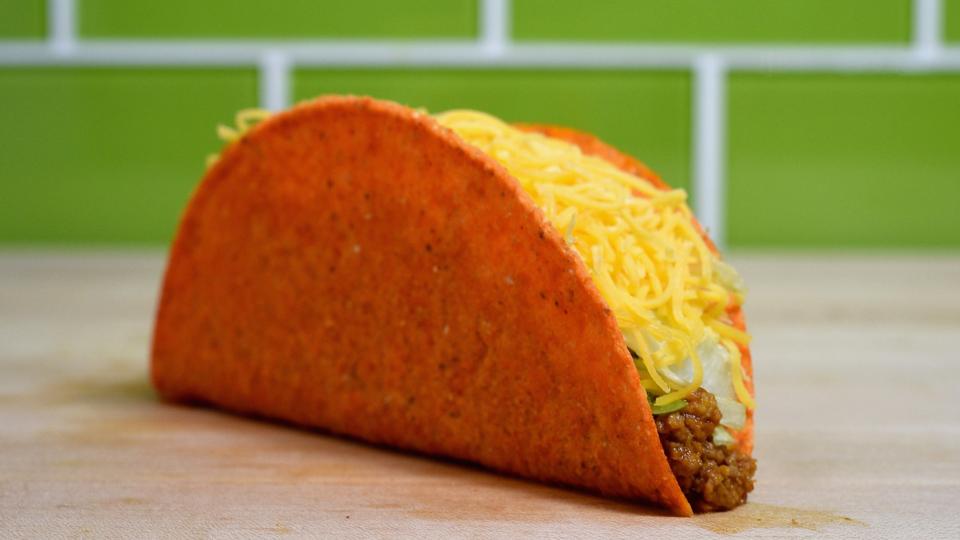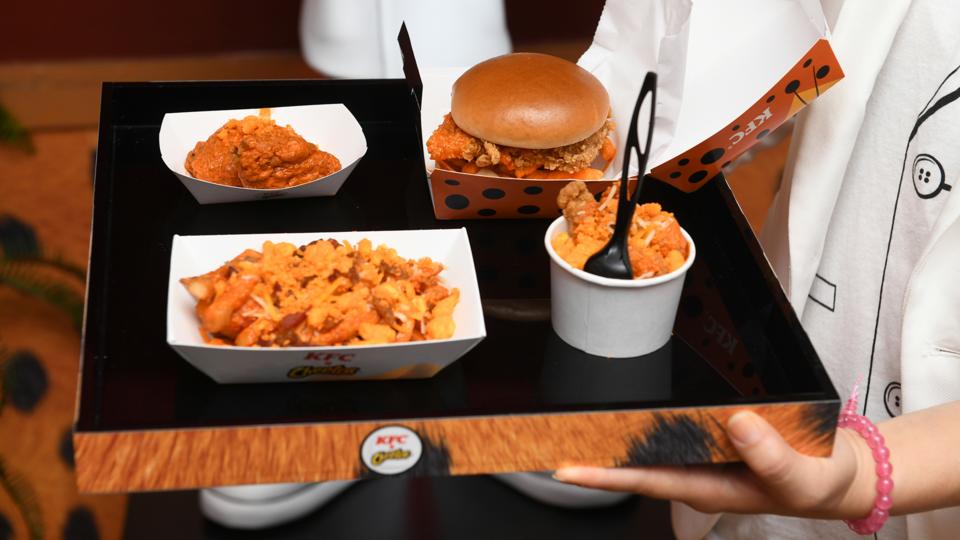The bizarre rise of fast food fused with snack foods
Instagram-ready and dripping with calories: inside the curious world of fast food-snack food fusion.
S
Starting a couple of weeks ago, Brits were given a golden opportunity. Or rather, a bright orange one: Taco Bell in the UK has introduced its Doritos Locos Taco, a taco with a shell made entirely of one big Dorito.
Tempted? Disgusted? Whatever your reaction, the Tex-Mex chain’s creation – which originally launched in the US in 2012 – has a track record of doing rather well. Media outlets hailed the hybrid creation as “one of the most successful fast food innovations of all time”, selling a billion units in the first year.
It’s no wonder, then, that more of these snack-food-fast-foods are popping up, especially in the US.
Last month, Pizza Hut rolled out a calzone shaped like a Cheez-It, a square cracker with a cheddar flavour, and, in August, KFC released a fried-chicken sandwich stuffed with Cheetos, puffy cheese-flavoured crisps.
Many of these items only pop up for a limited time, but they always make a high-in-saturated-fats splash, especially on social media. And, as evidenced by the success of the Doritos Locos Taco, they move product – a lot of it.
But how did we get to a place where a mash up between fast-food favourite and vending-machine staple are becoming commonplace? Is America’s fast food-crazed culture to blame?
The fast food-snack food hybrid that started it all in 2012, Taco Bell's Doritos taco shell, just debuted in the UK earlier this month (Credit: Getty Images)
Shock products – but familiar
Many of the brands and products involved in these campaigns are American, but experts caution associating the trend with the US exclusively. These fast food-snack food mashups can be found around the world.
“We try to stay away from generalisations,” says Ashley Rose Young, food historian at the Smithsonian Institute’s National Museum of American History in Washington, DC. “Given that fast food and snack foods are increasingly prevalent across the globe, [it’s best] to stay away from saying that any dish based on fast food or snack food is ‘an American thing’ – especially given the fact that some of the flavours and ingredients (or mock ingredients) in these dishes are taken from food cultures around the globe.”
All of these bizarro crossover and mash-up items might sound a bit dystopian, but for fast food chains, there are few things more effective than new products that are both somehow familiar and new at the same time – Adam Chandler
Sure, the US loves junk food and is a massive country whose huge highways gave rise to the modern roadside drive-through. But the origins of processed food are global, diverse and span thousands of years, from the salt-cured fish stored in pharaohs’ tombs in ancient Egypt to the invention of canning in 19th Century France. Fast forward to today, and processed foods are omnipresent the world over, whether it’s a packet of crisps in the glove box or shopping centres brimming with takeaways.
So maybe it’s no surprise creations like the Cheetos chicken sandwich aren’t limited to the US. In Japan in 2015, Kit Kats found their way into a whipped-cream-and-orange peel sandwich at First Kitchen, a fast food chain. Pizza Huts in Australia made pizza crusts from Doritos in 2014. Nutella was used in dessert burgers at McDonald’s in Italy in 2016. Last month, McDonald’s in the UK introduced its Galaxy Salted Caramel McFlurry, using a well-known chocolate brand.
Earlier this year, KFC introduced a fried chicken sandwich that's stuffed with Cheetos, a popular, crispy, cheesy, processed snack food (Credit: Getty Images)
“All of these bizarro crossover and mash-up items might sound a bit dystopian, but for fast food chains, there are few things more effective than new products that are both somehow familiar and new at the same time,” says Adam Chandler, author of Drive-Thru Dreams, a book that examines the link between fast food and American life.
The appeal of these over-the-top food mashups isn’t bound by geography – and are universal in their shock value. Burger King’s giant, deep-fried sticks of macaroni and cheese, shaped and flavoured like Cheetos, are certainly a… surprising addition to any menu, for example.
“These gimmicky offerings have taken off in recent years because they're carefully crafted, not just for physical consumption, but for digital consumption as well,” says Chandler. “They play well to younger crowds on social media, tend to be highly Instagrammable, and inspire curiosity, attention and disgust wherever they go.”
Fun, convenient, viral
Fast food companies have used social media aggressively and deftly. The snarky tone of Twitter accounts like Wendy’s is a pitch-perfect match for the tone of the internet, and has been well received by customers and analysts in terms of reaching and resonating with young and savvy social media users. What’s more, every time a snack-junk hybrid food hits the market, it’s usually for a limited period – but in that time, it typically sets social media aflame.
In the case of the KFC Cheetos chicken sandwich, YouTube video reviews of people eating it gathered millions of views. One in particular that combines ASMR and mukbang (broadcasting live to an audience while eating large amounts of food) has 1.2 million views alone. Similarly, a choreographed video of someone eating Pizza Hut’s Cheez-It pizza on TikTok, one of the fastest-growing social media apps and Gen Z hotspot, was “liked” more than 35,000 times. Social media blasts on Twitter and Vine were crucial to Taco Bell’s gargantuan success with the Doritos taco in 2012. Other stunts, like KFC’s Double Down, the sandwich which replaced pieces of bread with slabs of fried chicken, drove traffic to KFC.com by 29%.
“Millennials seem to love these kinds of gimmicks, so marketers use them,” says Marion Nestle, professor emerita of nutrition, food studies and public health at New York University. “People are bored with standard fast food so doing these kinds of things sparks interest.”
These are part of a long tradition of companies creating new, slightly outrageous, fast food and snack food combinations – more cheese, more meat, more layers - Ashley Rose Young
Jennifer Harris, director of marketing initiatives at the Rudd Center for Food Policy & Obesity at the University of Connecticut in the US, says that fast food companies combine social media and wacky dishes to hone in on young people, one of the biggest groups of fast food consumers in the US and the UK. She likens the snack-food-fast-food fads to vaping and energy drinks, which also target similar demographics, especially males between the ages of 13 and 24.
“Health is [generally] not their primary concern. Their concern is being cool, having their peers think they’re daring and exciting,” she says. “All their friends can see [on social media] they’ve bought and eaten this really cool new thing.” And then once something goes viral, it can be some of the most effective, cheapest marketing a company can use.
“These are part of a long tradition of companies creating new, slightly outrageous, fast food and snack food combinations – more cheese, more meat, more layers, adding sauces, [or] Cheetos, for crunch and a pop of flavour,” says food historian Young. “Fast food and snacks are typically marketed as fun and convenient – two things that appeal to many consumers.”
A now-familiar marketing play
Could this mean anything about the future of fast food?
Harris calls the mash-up craze a “race to the bottom”: “If one company is doing it, and it’s appealing to a group that you want to be your customers, then you have to do it – otherwise you’ll lose them.”
And although most of these companies are American and many of these snack foods originate in the US, Young points out that “they are not static products that solely reflect taste preferences of people living in the US. Rather, these products, once adopted in another country, shift and change, taking into account flavour profiles popular in that country,” like Kit Kats in Japan, which come in flavours like sake and matcha.(The chocolatey treat appeared in dessert pizzas in Japan in 2014.)
So it’s safe to say that, no matter where you live, your social media feed – if not your belly – could potentially be full of these mashed-up marvels for years to come. And if eating them isn’t your thing, you can always watch one of the thousands of videos of others doing it for you instead.




